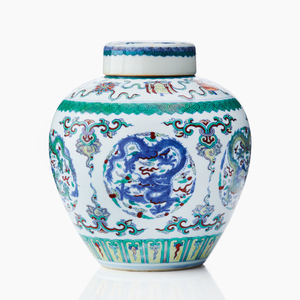A fine and rare doucai ‘Dragon’ jar and a cover
The ovoid body finely pencilled and enamelled in tones of green, yellow, aubergine and iron-red with five ascending and descending ’dragon’ medallions, each picked out in a different tone, framed at the corners with highly stylised lotus-flower spandrels, a stiff lotus petal border around the base and the Eight Buddhist Emblems, bajixiang, around the shoulder between bands of ruyi-heads, the base glazed and decorated in the centre with a six-character mark of Yongzheng inside blue double-circles. Period: Yongzheng (1723-1735) mark and period. Height: 19,5 cm.
Compare with the example in the British Museum, ref. Franks.338, 24 cm high from the collection of Sir A.W. Franks, illustrated in Sekai Toji Zenshu, Shogakukan Series, vol. 15, pl. 195; another in the Victoria and Albert, ref. 675-1907, 20 cm high and is illustrated by Gulland, Chinese Porcelain, 1911, vol. II, pls. 670-671. An identical jar illustrated in The Tsui Museum of Art, Chinese Ceramics, vol. IV, pl. 138, a further example in the E.T. Chow Collection was sold at Sotheby’s Hong Kong, 19 May 1981, lot 551, and again, 30 April 1996, lot 487. Two other examples from the Estate of Geraldine S. Violett were sold at Sotheby’s New York, 30 May 1990, lots 179 and 180. This particular design continued to be used in the two following reign periods of the Qing dynasty, as evidenced by two covered jars in the Palace Museum, Beijing, one bearing a Qianlong mark, the other a Daoguang mark, illustrated in Porcelains in Polychrome and Contrasting Colours, The Complete Collection of Treasures of the Palace Museum, Hong Kong, 1999, nos. 238 and 264.
View it on
Sale price
Estimate
Time, Location
Auction House
The ovoid body finely pencilled and enamelled in tones of green, yellow, aubergine and iron-red with five ascending and descending ’dragon’ medallions, each picked out in a different tone, framed at the corners with highly stylised lotus-flower spandrels, a stiff lotus petal border around the base and the Eight Buddhist Emblems, bajixiang, around the shoulder between bands of ruyi-heads, the base glazed and decorated in the centre with a six-character mark of Yongzheng inside blue double-circles. Period: Yongzheng (1723-1735) mark and period. Height: 19,5 cm.
Compare with the example in the British Museum, ref. Franks.338, 24 cm high from the collection of Sir A.W. Franks, illustrated in Sekai Toji Zenshu, Shogakukan Series, vol. 15, pl. 195; another in the Victoria and Albert, ref. 675-1907, 20 cm high and is illustrated by Gulland, Chinese Porcelain, 1911, vol. II, pls. 670-671. An identical jar illustrated in The Tsui Museum of Art, Chinese Ceramics, vol. IV, pl. 138, a further example in the E.T. Chow Collection was sold at Sotheby’s Hong Kong, 19 May 1981, lot 551, and again, 30 April 1996, lot 487. Two other examples from the Estate of Geraldine S. Violett were sold at Sotheby’s New York, 30 May 1990, lots 179 and 180. This particular design continued to be used in the two following reign periods of the Qing dynasty, as evidenced by two covered jars in the Palace Museum, Beijing, one bearing a Qianlong mark, the other a Daoguang mark, illustrated in Porcelains in Polychrome and Contrasting Colours, The Complete Collection of Treasures of the Palace Museum, Hong Kong, 1999, nos. 238 and 264.



